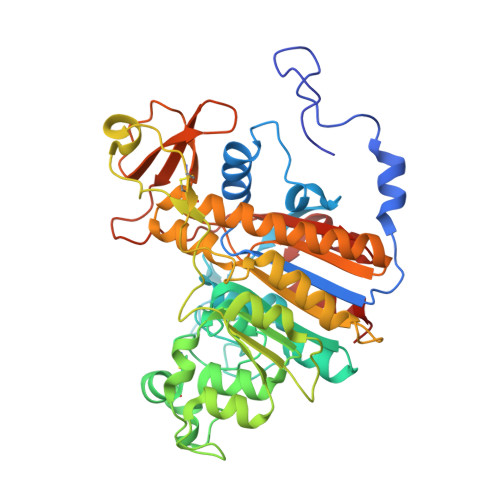High-resolution analysis of Zn(2+) coordination in the alkaline phosphatase superfamily by EXAFS and x-ray crystallography.
Bobyr, E., Lassila, J.K., Wiersma-Koch, H.I., Fenn, T.D., Lee, J.J., Nikolic-Hughes, I., Hodgson, K.O., Rees, D.C., Hedman, B., Herschlag, D.(2012) J Mol Biol 415: 102-117
- PubMed: 22056344
- DOI: https://doi.org/10.1016/j.jmb.2011.10.040
- Primary Citation of Related Structures:
3TG0 - PubMed Abstract:
Comparisons among evolutionarily related enzymes offer opportunities to reveal how structural differences produce different catalytic activities. Two structurally related enzymes, Escherichia coli alkaline phosphatase (AP) and Xanthomonas axonopodis nucleotide pyrophosphatase/phosphodiesterase (NPP), have nearly identical binuclear Zn(2+) catalytic centers but show tremendous differential specificity for hydrolysis of phosphate monoesters or phosphate diesters. To determine if there are differences in Zn(2+) coordination in the two enzymes that might contribute to catalytic specificity, we analyzed both x-ray absorption spectroscopic and x-ray crystallographic data. We report a 1.29-Å crystal structure of AP with bound phosphate, allowing evaluation of interactions at the AP metal site with high resolution. To make systematic comparisons between AP and NPP, we measured zinc extended x-ray absorption fine structure for AP and NPP in the free-enzyme forms, with AMP and inorganic phosphate ground-state analogs and with vanadate transition-state analogs. These studies yielded average zinc-ligand distances in AP and NPP free-enzyme forms and ground-state analog forms that were identical within error, suggesting little difference in metal ion coordination among these forms. Upon binding of vanadate to both enzymes, small increases in average metal-ligand distances were observed, consistent with an increased coordination number. Slightly longer increases were observed in NPP relative to AP, which could arise from subtle rearrangements of the active site or differences in the geometry of the bound vanadyl species. Overall, the results suggest that the binuclear Zn(2+) catalytic site remains very similar between AP and NPP during the course of a reaction cycle.
Organizational Affiliation:
Department of Chemistry, Stanford University, Stanford, CA 94305, USA.

















